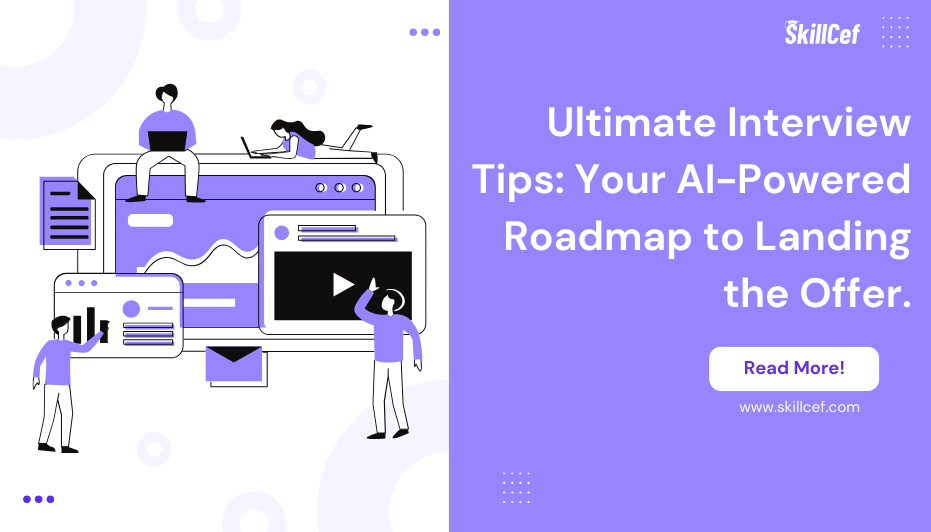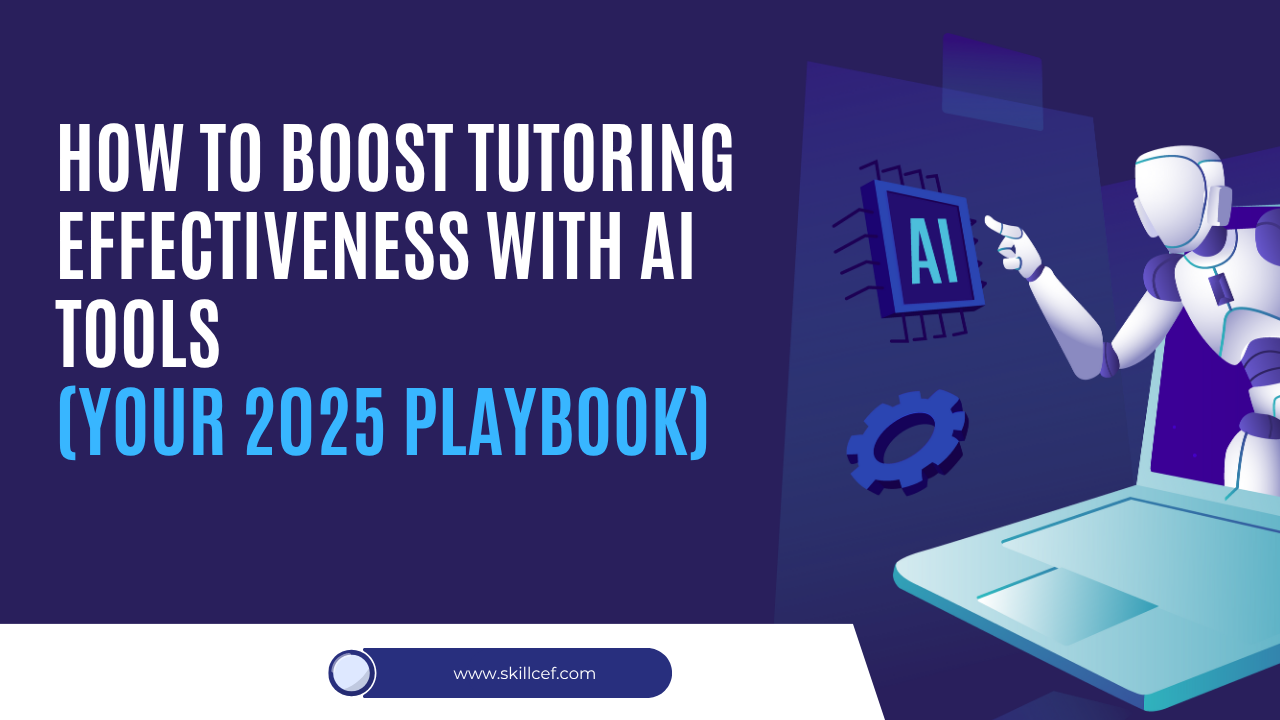
Ultimate Interview Tips: Your AI-Powered Roadmap to Landing the Offer.
Interviews make or break job opportunities. With proper preparation, you can walk in confident and walk out hired.
In 2025, the job market will remain competitive. Many qualified candidates apply for each open position. Research from JobScan shows that candidates who prepare for interviews are 3 times more likely to receive job offers than those who don’t.
This blog will help you stand out from other applicants with practical tips you can use right away.
Before the Interview: Setting Yourself Up for Success
Research the company thoroughly
Start by checking the company website. Look at their “About Us” page, mission statement, and recent news. Make notes about:
- What they do
- Who their customers are
- Their main products or services
- Recent achievements or challenges
- Company values and culture
Google the company name plus “news” to find recent developments. Follow them on LinkedIn and other social media. Read employee reviews on Glassdoor.
Study the job description like it’s a treasure map
Print the job description. Highlight:
- Required skills
- Preferred qualifications
- Key responsibilities
- Performance expectations
For each highlighted item, write down a specific example from your experience that shows you have that skill or quality. If you lack direct experience with something, think of transferable skills you can mention.
Know who you’ll meet
Ask your contact person for the names and titles of your interviewers. Look them up on LinkedIn. Notice:
- Their background
- How long they’ve been with the company
- Shared connections
- Common interests
This information helps you connect with them during the interview and ask smart questions.
Practice your responses
Make a list of common interview questions like:
- “Tell me about yourself”
- “Why do you want this job?”
- “What are your strengths and weaknesses?”
- “Tell me about a time you faced a challenge”
Record yourself answering each question. Watch the recordings to improve your delivery. Pay attention to:
- How clearly you speak
- Your facial expressions
- Hand gestures
- How concise your answers are
First Impressions: The Critical First 5 Minutes
Dress the Part
Your outfit matters more than you think. Research the company dress code beforehand. When in doubt, dress slightly more formally than employees typically do.
Men: Consider a clean, pressed suit in navy or gray. Match with a conservative tie and polished shoes.
Women: A skirt or pantsuit in a neutral color works well. Keep jewelry simple and minimal.
For casual workplaces: Neat chinos or dress pants with a button-down shirt or blouse.
Perfect Your Introduction
Practice a firm handshake – not too strong, not too weak. Make eye contact. Smile naturally. Say something like:
“Hello, I’m Emmanuel. Thank you for taking the time to meet with me today. I’m excited to learn more about the SEO position.”
Mind Your Body Language
- Stand tall
- Keep shoulders back
- Walk with purpose
- Sit up straight
- Lean slightly forward to show interest
- Keep hands visible, not under the table
Remote Interview First Impressions
For video interviews:
- Test your technology beforehand
- Use a neutral, clean background
- Position your camera at eye level
- Look at the camera, not the screen
- Dress professionally from head to toe (you might need to stand up)
- Close other programs that might cause notifications
- Put a “Do Not Disturb” sign on your door
Question Preparation Framework
The STAR Method Explained
Most behavioral questions can be answered using the STAR method:
Situation: Describe the context
Task: Explain what you needed to do
Action: Detail the steps you took
Result: Share the outcomes
Example STAR response to “Tell me about a time you solved a problem”:
Situation: “At my previous job, customer complaints increased by 15% after we changed our return policy.”
Task: “As customer service manager, I needed to address these complaints while maintaining the new policy.”
Action: “I analyzed complaint patterns, identified confusion about the policy as the main issue, created a simple visual guide explaining the policy, trained staff on clearer communication, and added a FAQ section to our website.”
Result: “Within two months, complaints decreased to below previous levels, and customer satisfaction scores improved.”
Types of Interview Questions
Behavioral Questions
- “Describe a time when…”
- “Give an example of…”
- “Tell me about how you handled…”
These questions reveal how you’ve behaved in past situations. Your past behavior predicts future performance.
Technical Questions
- Specific knowledge questions
- Problem-solving scenarios
- Skills demonstrations
These assess your technical abilities and expertise relevant to the role.
Situational Questions
- “What would you do if…”
- “How would you handle…”
- “Imagine a scenario where…”
These evaluate your thought process and how you might handle future situations.
Stress Questions
- Deliberately challenging questions
- Questions that seem hostile
- Unexpected curveballs
These test your composure under pressure.
Red Flag Questions and How to Handle Them
“Why did you leave your last job?”
Bad answer: Criticizing previous employer
Good answer: Focus on what you’re seeking in a new role
“What’s your biggest weakness?”
Bad answer: “I’m a perfectionist” or “I work too hard.”
Good answer: Mention a real skill you’ve struggled with and steps you’ve taken to improve
“Tell me about a time you failed”
Bad answer: Denying failures or blaming others
Good answer: Describe a specific situation, accept responsibility, explain what you learned
The Art of Storytelling in Interviews
Stories stick in people’s minds. Facts fade. Well-crafted stories make you memorable.
Story Arc for Your Career
Think of your career as a journey with:
- Beginning: Your education and early inspiration
- Challenges: Obstacles you’ve overcome
- Growth: Skills and wisdom gained
- Present: Your current capabilities
- Future: Where you’re headed next
Story Bank
Create a collection of 6-8 stories that showcase different skills:
- Leadership
- Problem-solving
- Teamwork
- Overcoming failure
- Taking initiative
- Learning quickly
- Managing conflict
Each story should last 1-2 minutes. Practice until they flow naturally.
Story Structure
Good interview stories follow this pattern:
- Hook – Grab attention with an interesting setup
- Problem – Describe the challenge clearly
- Action – Explain what YOU did specifically
- Result – Share measurable outcomes
- Relevance – Connect to the job you’re interviewing for
Beyond Rehearsed Answers: Authentic Communication
People can tell when you’re reciting memorized answers. Find the balance between preparation and authenticity.
✅ DO:
- Prepare key points, not entire scripts
- Take brief pauses to collect your thoughts
- Show appropriate emotion
- Admit when you don’t know something
- Ask clarifying questions if needed
❌ DON’T:
- Rush to fill silence
- Use corporate buzzwords extensively
- Interrupt the interviewer
- Hide your personality
- Pretend to know something you don’t
Recovering from Mistakes
Everyone makes mistakes in interviews. How you recover matters more than the mistake itself.
If you misspeak: “Let me clarify that point…”
If you go blank: “That’s a great question. Let me think about that for a moment.”
If you ramble: “To summarize my main point…”
The Two-Way Street: Questions That Showcase Your Value
Asking thoughtful questions shows you’re serious about the position and thinking critically about how you’d fit in.
Questions About the Role:
- “What does success look like in this position after 90 days? After one year?”
- “What are the biggest challenges someone in this position faces?”
- “How is performance measured for this role?”
Questions About the Team:
- “Can you tell me about the team I’d be working with?”
- “What’s the communication style of the team?”
- “How does this team celebrate wins?”
Questions About Growth:
- “What professional development opportunities exist in this role?”
- “How have others in this position grown within the company?”
- “What skills would make someone exceptional in this role versus merely good?”
Questions About the Interviewer:
- “What do you enjoy most about working here?”
- “How long have you been with the company, and what keeps you here?”
- “What has been your proudest moment at this company?”
Interview Day Logistics: Setting the Stage for Success
What to Bring
- 5 copies of your resume
- List of references
- Portfolio of work (if applicable)
- Notepad and pen
- Questions prepared for the interviewer
- Breath mints (not gum)
- Water bottle
- Directions and contact information
What to Leave Behind
- Heavy perfume or cologne
- Bulky bags or purses
- Coffee or other beverages
- Chewing gum
- Cell phone ringers
Arrival Strategies
For in-person interviews:
- Do a test drive to the location before interview day
- Plan to arrive 10-15 minutes early
- Use restroom before checking in
- Greet everyone politely, from security guards to receptionists
- Use waiting time to breathe deeply and review notes
For virtual interviews:
- Log in 5-10 minutes early
- Have a backup device charged and ready
- Keep interview link easily accessible
- Close unnecessary programs
- Turn on “do not disturb” settings for your devices
Managing Interview Anxiety
Physical techniques:
- Deep breathing: 4 counts in, hold for 4, 4 counts out
- Progressive muscle relaxation: Tense and release muscle groups
- Power pose: Stand in confident stance for 2 minutes before interview
- Exercise lightly the morning of the interview
Mental techniques:
- Visualization: Imagine successful interview scenarios
- Positive self-talk: Replace “I might fail” with “I’m prepared and capable”
- Focus on giving value: Shift from “Will they like me?” to “How can I help them?”
- Remember: Interviewers want you to succeed
Body Language Mastery
Your nonverbal communication speaks volumes.
Power Positions
- Sit with back straight but not rigid
- Keep shoulders back and open
- Place feet flat on floor
- Rest arms on chair arms or table edge
- Take up appropriate space – don’t shrink yourself
Active Listening Signals
- Nod occasionally
- Maintain comfortable eye contact (look away briefly every 5-7 seconds)
- Tilt head slightly
- Lean forward slightly
- Mirror interviewer’s energy level
- Avoid fidgeting, hair twirling, face touching
Cultural Considerations
- Research culture-specific greeting customs
- Note appropriate personal space expectations
- Learn about eye contact norms
- Understand handshake expectations
- Research formality levels
Salary and Negotiation: The Delicate Dance
Timing is everything. Wait for the employer to bring up compensation first.
Before the Interview:
- Research salary ranges on Glassdoor, PayScale, and industry reports
- Know your “walk away” number
- Calculate your living expenses
- Consider entire compensation package, not just salary
During the Discussion:
When asked about salary expectations:
Option 1: Give a range. “Based on my research and experience, I’m looking for something in the $X to $Y range, though I’m flexible depending on the total compensation package.”
Option 2: Turn the question back. “I’d like to learn more about the responsibilities first. That said, I’m sure you have a range in mind for this role – could you share that with me?”
Remember to Consider:
- Health benefits
- Retirement plans
- Vacation time
- Remote work options
- Professional development
- Stock options
- Bonuses
- Flexible scheduling
Following Up: The Often Overlooked Final Step
Many candidates forget this crucial step. Don’t be one of them.
Thank-You Note Best Practices
- Send within 24 hours
- Email is acceptable; handwritten notes stand out
- Keep it brief – 3-4 paragraphs
- Thank them for their time
- Restate your interest in the position
- Reference specific conversation points
- Reiterate your key qualifications
- Provide any promised follow-up information
- Check for typos and errors
Sample Thank-You Email:
Subject: Thank You for the [Position] Interview
Dear [Interviewer’s Name],
Thank you for taking the time to discuss the [Position] role with me today. I enjoyed learning more about [specific project or company initiative discussed] and how the team is working to [company goal].
Our conversation reinforced my enthusiasm for the position and my confidence that my skills in [relevant skill] and experience with [relevant experience] would enable me to make valuable contributions to your team.
I was particularly excited about the opportunity to [specific aspect of job that interests you]. As mentioned, I’ve attached the [any promised documents].
Please don’t hesitate to reach out if you need any additional information. I look forward to hearing from you about the next steps in the process.
Best regards,
[Your Name]
[Your Phone]
Follow-up Timeline
- Send thank-you within 24 hours
- If given a timeline for a decision, wait until after that date
- If no timeline given, follow up 7-10 days after interview
- Maximum two follow-ups before moving on
- Space follow-ups 7-10 days apart
- Keep messages brief and professional
Special Scenarios
Panel Interview Strategies
- Research all panel members if possible
- Make eye contact with each person when answering
- Address your answers primarily to the person who asked, but engage others
- Note each person’s name and role
- Send individual thank-you notes afterward
Behavioral Assessment Interviews
- These focus on past behavior and situations
- Prepare extra STAR method stories
- Include both successful outcomes and learning experiences
- Be specific about YOUR contributions in team settings
- Expect follow-up questions that dig deeper
Addressing Employment Gaps
- Be honest without oversharing
- Focus on productive activities during gaps:
- Skills development
- Volunteer work
- Consulting/freelance
- Personal projects
- Family responsibilities
- Emphasize eagerness to return to work
- Highlight the relevance of any skills gained during the gap
Second and Final Round Differences
- Expect more specific technical questions
- Prepare to meet more senior staff
- Research company more deeply
- Bring ideas for how you’d approach the role
- Be ready for “fit” questions about company culture
- Expect more in-depth discussions about salary and benefits
Interview Preparation Checklist
One Week Before
□ Research company thoroughly □ Study job description and match experiences □ Prepare STAR stories □ Research typical salary range □ Practice answers to common questions □ Choose interview outfit and try it on □ Plan route to interview location
Day Before
□ Print 5 copies of resume □ Prepare reference list □ Review company research □ Confirm interview time and location □ Set out clothes and essentials □ Get good sleep □ Prepare questions for interviewer
Morning Of
□ Eat a good meal □ Bring water □ Allow extra time for travel □ Turn phone to silent □ Review key points about the role □ Do confidence-building exercises □ Arrive 10-15 minutes early
Final Thoughts
Interviewing is a skill that improves with practice. Each interview teaches you something valuable, whether you get the job or not.
After each interview, reflect on what went well and what you could improve. Write down difficult questions for future preparation.
Remember that interviews go both ways – you’re also deciding if this company and role are right for you. Trust your instincts about company culture and team dynamics.
With preparation and practice, you’ll become more comfortable and confident in interviews. Soon, you’ll walk into each one ready to shine.
The future of upskilling is ?????-??, ??-??????, ??? ????? ?????? ????-????? ????????. But what if you could get ??????? ?? ???????? while working on industry-relevant challenges? This is where SkillCef comes in, We’re building something ????-????????– an ??-???????, ??????????-??? ??????? ?????????? to help professionals and students. Visit our portal now and explore readily available skill-building resources designed for your success: – SkillCef AI Powered Hiring Portal

